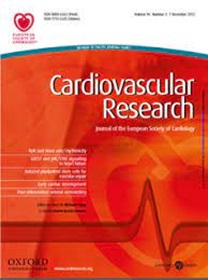氧化ldl诱导的FOXS1介导胆固醇转运功能障碍和炎性体激活,驱动主动脉瓣钙化。
IF 13.3
1区 医学
Q1 CARDIAC & CARDIOVASCULAR SYSTEMS
引用次数: 0
摘要
随着人口老龄化,选择性主动脉瓣疾病(CAVD)变得越来越普遍;然而,目前没有可用的药物治疗。在早期脂质沉积过程中,低密度脂蛋白介导慢性炎症并加速钙化进程。然而,这一机制仍需进一步探索。方法和结果研究发现人瓣膜间质细胞(VICs)中的转录因子FOXS是主动脉瓣钙化的关键调节因子。通过Bulk RNA-seq和qRT-PCR分析,证实了氧化LDL (oxLDL)在vic中诱导FOXS1。为了阐明FOXS1在成骨分化中的作用,我们利用小干扰RNA和重组腺病毒调控了FOXS1在vic中的表达。高脂饮食(HFD)喂养Apoe-/- FOXS1 -/-小鼠作为体内模型,研究FOXS1在主动脉瓣钙化中的作用。大量RNA-seq、qRT-PCR和western blot分析表明,oxLDL在VICs中显著激活FOXS1, FOXS1的沉默抑制oxLDL诱导的成骨分化。缺失FOXS1可显著降低饲喂hfd的Apoe-/-小鼠主动脉瓣钙化,主动脉瓣小叶钙沉积减少。RNA-seq和染色质免疫沉淀测序揭示了FOXS1的调控机制,揭示了FOXS1与BSCL2启动子的直接相互作用,随后通过PPARγ/LXRα轴抑制ABCA1和ABCG1的表达。本研究证实FOXS1通过BSCL2、ABCA1和ABCG1介导血管内皮细胞胆固醇转运功能障碍,并证实细胞内胆固醇积累可激活NLRP3炎性体,促进血管内皮细胞成骨分化。此外,IMM-H007和重组BSCL2在体外和体内均能降低主动脉瓣钙化。结论氧化低密度脂蛋白诱导的转录因子FOXS1通过BSCL2/PPARγ/LXRα轴抑制ABCA1和ABCG1的表达,促进VICs中胆固醇转运功能障碍和NLRP3炎性体的激活,从而加速CAVD的进展。本文章由计算机程序翻译,如有差异,请以英文原文为准。
Oxidized LDL-induced FOXS1 mediates cholesterol transport dysfunction and inflammasome activation to drive aortic valve calcification.
AIMS
Calcific aortic valve disease (CAVD) is becoming more prevalent with the population ageing; however, there is currently no medical therapy available. During early lipid deposition, low-density lipoprotein (LDL) mediates chronic inflammation and accelerates calcification progression. However, the mechanism still needs to be further explored.
METHODS AND RESULTS
The study identified the transcription factor FOXS in human valvular interstitial cells (VICs) as a pivotal regulator in aortic valve calcification. Bulk RNA-seq and qRT-PCR analysis were conducted to establish that FOXS1 is induced by oxidized LDL (oxLDL) in VICs. To elucidate the role of FOXS1 in osteogenic differentiation, small interfering RNA and recombinant adenovirus were utilized to modulate FOXS1 expression in VICs. High-fat diet (HFD)-fed Apoe-/-Foxs1-/- mice served as an in vivo model to investigate the role of FOXS1 in aortic valve calcification. Analysis from bulk RNA-seq, qRT-PCR, and western blot indicated significant activation of FOXS1 by oxLDL in VICs, with silencing of FOXS1 inhibiting oxLDL-induced osteogenic differentiation. Deletion of FOXS1 markedly reduced aortic valve calcification in HFD-fed Apoe-/- mice, as shown by decreased calcium deposition in the aortic valve leaflets. RNA-seq and chromatin immunoprecipitation sequencing were performed to reveal the regulatory mechanisms of FOXS1, uncovering direct interactions with the promoter of BSCL2, which subsequently inhibits the expression of ABCA1 and ABCG1 via the PPARγ/LXRα axis. The study demonstrated that FOXS1 mediates VICs' cholesterol transport dysfunction through BSCL2, ABCA1, and ABCG1 using Bodipy-cholesterol and showed that intracellular cholesterol accumulation can activate the NLRP3 inflammasome, promoting osteogenic differentiation of VICs. Additionally, it was found that IMM-H007 and recombinant BSCL2 could reduce aortic valve calcification both in vitro and in vivo.
CONCLUSION
We identified that an oxLDL-induced transcription factor FOXS1 inhibits ABCA1 and ABCG1 expression via the BSCL2/PPARγ/LXRα axis and promotes cholesterol transport dysfunction and the activation of NLRP3 inflammasome in VICs, thereby accelerating the progression of CAVD.
求助全文
通过发布文献求助,成功后即可免费获取论文全文。
去求助
来源期刊

Cardiovascular Research
医学-心血管系统
CiteScore
21.50
自引率
3.70%
发文量
547
审稿时长
1 months
期刊介绍:
Cardiovascular Research
Journal Overview:
International journal of the European Society of Cardiology
Focuses on basic and translational research in cardiology and cardiovascular biology
Aims to enhance insight into cardiovascular disease mechanisms and innovation prospects
Submission Criteria:
Welcomes papers covering molecular, sub-cellular, cellular, organ, and organism levels
Accepts clinical proof-of-concept and translational studies
Manuscripts expected to provide significant contribution to cardiovascular biology and diseases
 求助内容:
求助内容: 应助结果提醒方式:
应助结果提醒方式:


